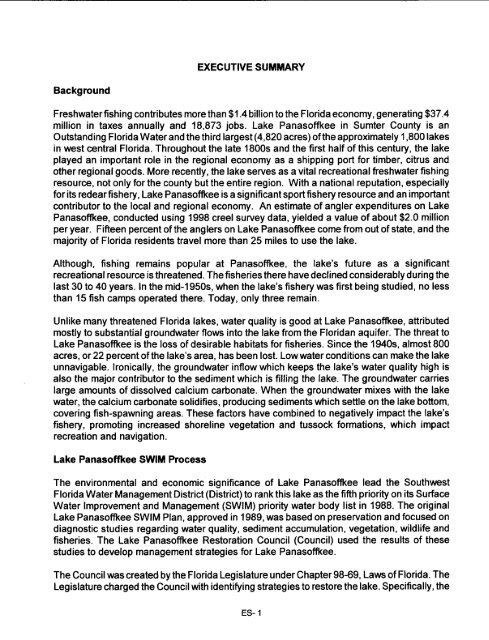Lake Panasoffkee SWIM Plan - Southwest Florida Water ...
Lake Panasoffkee SWIM Plan - Southwest Florida Water ...
Lake Panasoffkee SWIM Plan - Southwest Florida Water ...
You also want an ePaper? Increase the reach of your titles
YUMPU automatically turns print PDFs into web optimized ePapers that Google loves.
EXECUTIVE SUMMARY<br />
Background<br />
Freshwater fishing contributes more than $1.4 billion to the <strong>Florida</strong> economy, generating $37.4<br />
million in taxes annually and 18,873 jobs. <strong>Lake</strong> <strong>Panasoffkee</strong> in Sumter County is an<br />
Outstanding <strong>Florida</strong> <strong>Water</strong> and the third largest (4,820 acres) of the approximately 1,800 lakes<br />
in west central <strong>Florida</strong>. Throughout the late 1800s and the first half of this century, the lake<br />
played an important role in the regional economy as a shipping port for timber, citrus and<br />
other regional goods. More recently, the lake serves as a vital recreational freshwater fishing<br />
resource, not only for the county but the entire region. With a national reputation, especially<br />
for its redearfishery, <strong>Lake</strong> <strong>Panasoffkee</strong> is a significant sport fishery resource and an important<br />
contributor to the local and regional economy. An estimate of angler expenditures on <strong>Lake</strong><br />
Panasoh’kee, conducted using 1998 creel survey data, yielded a value of about $2.0 million<br />
per year. Fifteen percent of the anglers on <strong>Lake</strong> <strong>Panasoffkee</strong> come from out of state, and the<br />
majority of <strong>Florida</strong> residents travel more than 25 miles to use the lake.<br />
Although, fishing remains popular at <strong>Panasoffkee</strong>, the lake’s future as a significant<br />
recreational resource is threatened. The fisheries there have declined considerably during the<br />
last 30 to 40 years. In the mid-l950s, when the lake’s fishery was first being studied, no less<br />
than 15 fish camps operated there. Today, only three remain.<br />
Unlike many threatened <strong>Florida</strong> lakes, water quality is good at <strong>Lake</strong> <strong>Panasoffkee</strong>, attributed<br />
mostly to substantial groundwater flows into the lake from the <strong>Florida</strong>n aquifer. The threat to<br />
<strong>Lake</strong> <strong>Panasoffkee</strong> is the loss of desirable habitats for fisheries. Since the 194Os, almost 800<br />
acres, or 22 percent of the lake’s area, has been lost. Low water conditions can make the lake<br />
unnavigable. Ironically, the groundwater inflow which keeps the lake’s water quality high is<br />
also the major contributor to the sediment which is filling the lake. The groundwater carries<br />
large amounts of dissolved calcium carbonate. When the groundwater mixes with the lake<br />
water, the calcium carbonate solidifies, producing sediments which settle on the lake bottom,<br />
covering fish-spawning areas. These factors have combined to negatively impact the lake’s<br />
fishery, promoting increased shoreline vegetation and tussock formations, which impact<br />
recreation and navigation.<br />
<strong>Lake</strong> Panasornee <strong>SWIM</strong> Process<br />
The environmental and economic significance of <strong>Lake</strong> <strong>Panasoffkee</strong> lead the <strong>Southwest</strong><br />
<strong>Florida</strong> <strong>Water</strong> Management District (District) to rank this lake as the fifth priority on its Surface<br />
<strong>Water</strong> Improvement and Management (<strong>SWIM</strong>) priority water body list in 1988. The original<br />
<strong>Lake</strong> Panasoh’kee <strong>SWIM</strong> <strong>Plan</strong>, approved in 1989, was based on preservation and focused on<br />
diagnostic studies regarding water quality, sediment accumulation, vegetation, wildlife and<br />
fisheries. The <strong>Lake</strong> <strong>Panasoffkee</strong> Restoration Council (Council) used the results of these<br />
studies to develop management strategies for <strong>Lake</strong> <strong>Panasoffkee</strong>.<br />
The Council was created by the <strong>Florida</strong> Legislature under Chapter 98-69, Laws of <strong>Florida</strong>. The<br />
Legislature charged the Council with identifying strategies to restore the lake. Specifically, the<br />
ES- 1
















